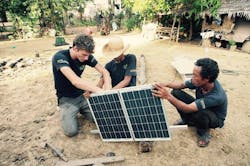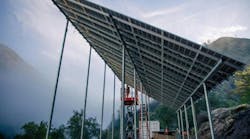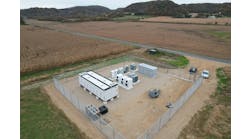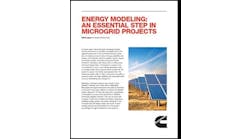Schneider Electric’s impact investing arm recently led a “pre-seed” funding round that paves the way for Australia startup Okra Solar to expand its off-grid microgrid product into Southeast Asia.
Okra Solar offers the Okra Pod — a systems controller that creates modular microgrids by networking and balancing rooftop solar PV and battery energy storage with electricity loads. The Okra Pod serves households, businesses and community facilities.
The parties did not reveal the amount, terms and conditions of the investment by Schneider’s Energy Access Ventures Fund.
Designing a more efficient off-grid microgrid
Microgrid Knowledge spoke with Okra Solar CEO and co-founder Afnan Hannan to learn more about the company, its Okra Pod smart microgrid controller and its expansion plans.
Working with three local distributors, Okra Solar first deployed the Okra Pod about 18 months ago to create rural, off-grid solar-storage microgrids in Cambodia, Hannan said. Three are up and running to date.
“We wanted to bring our background in smart buildings and IoT software to the off-grid energy space,” he said.
Okra Solar began testing the market for its technology by deploying remote solar PV system monitoring devices in rural Cambodia.
“Immediately we found a problem — upwards of 50 percent of the power generated by rooftop PV systems was being wasted simply because there was nowhere for the power to go. Poor battery management was a problem, as well,” Hannan said.
That was due to the fact that systems developers were over-sizing rooftop PV-battery systems and weren’t doing a good job monitoring or maintaining generation or energy storage capacity.
“We did a quick analysis and then hooked up a bunch of home solar PV systems to Okra Pods so as to distribute power where it’s needed in an intelligent, efficient way,” Hannan said.
As a result, Okra Solar and its distributors were able to design smaller-scale microgrid systems that have proved to be more efficient, reliable and less costly.
“Systems sizes are smaller, so equipment and customer costs are lower. In addition, the systems are more reliable and productive — they operate 24×7 and are able to serve productive loads, such as refrigeration, much more effectively by pulling power from a network,” Hannan said.
Ensuring optimal energy generation, storage and distribution
The Okra Pod technology optimises battery charging and discharging. Intelligent power distribution is another core microgrid control function.
“Installation of smart meters along with the Okra Pod lets us know exactly how much power is being used by every household or small business connected to the network. In effect, customers are paying for energy-as-a-service. If the household isn’t able to pay, their service can be shut down until they are able to. That generation and energy storage capacity is still available to other network subscribers, however,” Hannan said.
Okra Solar will use the capital provided by pre-seed funding-round investors to refine engineering of its technology, scale up equipment production and expand in Cambodia and other Southeast Asian countries. Okra expects to deploy another 100 Okra Pods in Cambodia by the end of this year.
Turning to new markets, Okra has received orders from Nigeria and Tanzania. The Philippines, however, is at the top of Okra Solar’s expansion agenda.
Hannan said that the Philippines has about 2.4 million off-grid households. President Rodrigo Duterte, along with other government leaders across the region, has set a goal of universal energy access, in the case of the Philippines by 2022. Government regulators are in the midst of implementing new rules and launching new programs that are fueling growth in solar PV, battery energy storage and microgrid technology and systems.
Off-grid microgrid market potential in the Philippines
Working with Filipino solar-storage distribution partners, Okra has deployed 70 Okra Pods and two microgrids in rural communities so far.
“We can build ‘plug and play’ microgrids like you would build something with LEGO blocks. As consumption increases, we simply add solar PV or battery energy storage capacity and controllers,” Hannan said.
The Okra Pod is equipped with remote monitoring, load balancing and energy management capabilities that extend from individual homes of businesses to the aggregate microgrid network level.
The ability to closely monitor and manage energy generation, storage, distribution and consumption enables microgrid systems adjust changing conditions on the fly — a reduction in solar generation due to shading or cloud cover, or the need to replace an individual battery, for example. “That really reduces operations and maintenance costs, a major cost of electrification,” Hannan said.
Schneider funding lowers production costs
Okra Solar can set up an off-grid, solar-storage microgrid that reliably provides enough power 24×7 for lights, fans, mobile phone chargers, TVs or small refrigerators at a cost roughly equivalent to US$300. That’s for a standard home solar PV-battery storage system, according to Hannan.
If a household wants to consume more energy, all they need to do is flip a switch and they’ll have enough electricity to power a small refrigerator or water pump. “This is our pilot phase, we’re bringing our production cost down, in large part due to Schneider’s pre-seed funding,” he said.
Track news about off-grid microgrid projects. Subscribe to the free Microgrid Knowledge newsletter.







